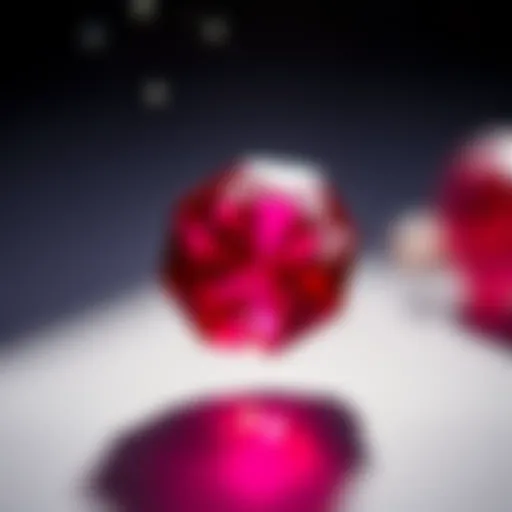Understanding Lab-Made Diamonds: A Comprehensive Exploration
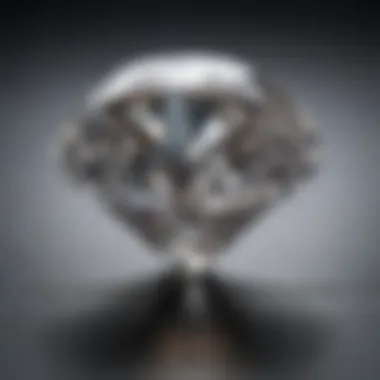

Intro
The increasing interest in lab-made diamonds reshapes the landscape of modern gemology. The allure of these captivating gemstones goes beyond their sparkle. It invites exploration into authenticity, production processes, and the ethical implications surrounding their creation. This article aims to provide a comprehensive understanding of what lab-created diamonds are, how they differ from natural ones, and why they matter in today’s market.
Gemstone Overview
Definition and Characteristics
Lab-made diamonds, also known as synthetic or cultured diamonds, are gemstones produced in controlled environments using advanced technological methods. Unlike natural diamonds, formed deep within the Earth over millions of years, lab-made diamonds exhibit identical physical, chemical, and optical properties. This means they possess the same brilliance and hardness, measuring 10 on the Mohs scale, which characterizes diamonds as one of the hardest known materials.
Key characteristics of lab-made diamonds include:
- Clarity: Typically, lab-made diamonds display fewer inclusions compared to natural diamonds.
- Color: They can be produced in various colors, from colorless to shades of pink, blue, and yellow.
- Cost: Generally, lab-made diamonds are more affordable, often costing 20% to 40% less than their natural counterparts.
Classification of Gemstones
Gemstones can be classified based on various criteria. In the case of diamonds, the main classifications include:
- Natural Diamonds: Formed naturally over geological time.
- Lab-Made Diamonds: Created using human-engineered methods.
Understanding these distinctions helps consumers make informed choices based on quality, value, and preferences.
Properties of Gemstones
Physical Properties
The physical properties of lab-made diamonds mirror those of natural diamonds, encompassing:
- Hardness: Lab-made diamonds are extremely hard, making them highly resistant to scratches.
- Refractive Index: This property gives diamonds their signature sparkle. Lab-made diamonds exhibit an identical refractive index to natural diamonds.
- Specific Gravity: They have a similar weight, ensuring consistency in gemstone quality.
Chemical Properties
Chemically, lab-made diamonds consist of crystalline carbon atoms arranged in a diamond lattice structure, indistinguishable from natural diamonds. This includes:
- Composition: Both lab-made and natural diamonds consist primarily of carbon, which forms their unique properties.
- Impurities: While lab-made diamonds can have fewer impurities, some specific types can still occur, impacting color and clarity.
"Lab-created diamonds should not be seen as lesser - they redefine traditional gemology, merging science with art."
Exploring these properties allows enthusiasts to appreciate the innovation behind lab-made diamonds.
Understanding the nuances of lab-made diamonds cultivates a deeper appreciation for their role in modern gemology. This exploration serves as a gateway to recognizing their authenticity and ethical impact in the diamond industry.
Defining Lab-Made Diamonds
The topic of lab-made diamonds is essential in understanding today's jewelry market and the broader implications for gemology. This section explores the foundational aspects of lab-created diamonds, clarifying what they are and their significance in the industry.
By defining lab-made diamonds clearly, readers can appreciate the evolving narrative surrounding these gems. They represent not just a technological advancement but also address ethical considerations associated with traditional diamond mining. The emergence of lab-made diamonds has sparked discussions about authenticity, value, and consumer preference.
What Are Lab-Made Diamonds?
Lab-made diamonds, also known as synthetic diamonds or cultured diamonds, are created in controlled laboratory settings using technology designed to replicate the natural processes that form diamonds in the earth. These diamonds possess the same physical, chemical, and optical properties as their natural counterparts, making them indistinguishable to the naked eye. The key difference lies in their origin: while natural diamonds are formed over millions of years beneath the Earth's surface, lab-made diamonds can be produced in a matter of weeks.
The rise of lab-made diamonds is reshaping consumer perception. Many buyers find them appealing due to their lower cost and ethical production methods. This shift in preference encourages a deeper understanding of the value assigned to diamonds based on their origin rather than just their physical attributes.
Types of Lab-Made Diamonds
Lab-made diamonds are primarily produced using two methods: High Pressure High Temperature (HPHT) and Chemical Vapor Deposition (CVD). Each method has its own unique process and benefits, further defining the landscape of lab-created gems.
High Pressure High Temperature (HPHT)
The HPHT method simulates the extreme heat and pressure conditions found deep within the Earth where natural diamonds form. In this process, carbon is placed in a chamber where it undergoes a combination of high pressure and high temperature, accelerating diamond crystallization.
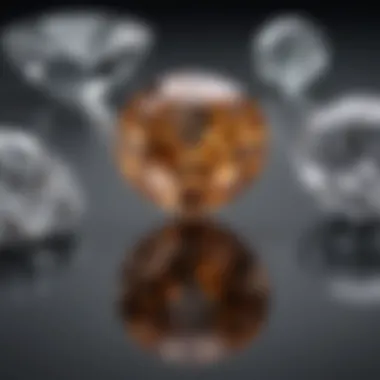

One key characteristic of HPHT is its ability to create diamonds that are nearly identical to natural gems both in appearance and structure. This process is beneficial for manufacturers seeking to replicate the nuances of natural diamonds.
However, HPHT diamonds may have different inclusions or color characteristics compared to natural diamonds. These factors can affect the diamond's value and appeal, depending on consumer preferences.
Chemical Vapor Deposition ()
The CVD method involves dissolving carbon gas in a vacuum chamber, leading to the deposition of carbon atoms onto a substrate. This process encourages the formation of diamond crystals as the gases react under controlled conditions.
A significant advantage of CVD is its ability to produce high-quality diamonds with fewer impurities. This method allows for impressive customization, as different gases can impart various colors to the diamonds. Thus, CVD diamonds are celebrated for their clarity and potential for production of unique gemstones.
Nevertheless, CVD diamonds require more advanced technology and time, potentially making them pricier to produce compared to HPHT diamonds.
In summary, both HPHT and CVD techniques represent remarkable advancements in diamond technology. Each method contributes to the growing market of lab-made diamonds, catering to diverse consumer needs.
The Science Behind Lab-Made Diamonds
The significance of the science behind lab-made diamonds cannot be overstated. Lab-grown diamonds, often indistinguishable from their natural counterparts, are products of sophisticated scientific methods that yield exceptional quality and precision. These diamonds provide a compelling alternative in the gemstone market, appealing to consumers who are focused on both beauty and ethical considerations. Understanding the processes involved in creating these diamonds sheds light on their authenticity, as well as their role in promoting sustainability within the jewelry industry.
Crystal Growth Process
The crystal growth process represents the core of lab-made diamond production. Two primary methods are employed: High Pressure High Temperature (HPHT) and Chemical Vapor Deposition (CVD). Each method offers distinctive advantages and insights into the overall production landscape.
HPHT Method
The High Pressure High Temperature (HPHT) method is a cornerstone in the production of lab-created diamonds. It simulates the natural conditions under which diamonds form deep within the Earth’s mantle. This method involves applying extreme pressure and high temperatures to carbon materials, facilitating crystal growth.
A key characteristic of the HPHT method is its ability to create diamonds with minimal defects, which enhances clarity and brilliance. This makes HPHT diamonds particularly appealing to purists who prioritize quality. However, a unique feature of HPHT is its potential to produce diamonds with metallic inclusions, which can affect the gem's overall appearance.
The advantages of the HPHT method include speed and volume of production, producing diamonds in a matter of weeks compared to the millions of years required for natural formation. Nevertheless, the costs associated with equipment and energy consumption can be substantial, making it a considerable investment for manufacturers.
Method
The Chemical Vapor Deposition (CVD) method offers another approach to creating lab-made diamonds. In this process, a carbon-containing gas is introduced into a chamber, where it breaks down and deposits carbon atoms onto a substrate. This method allows for meticulous control over diamond growth and composition.
One key characteristic of the CVD method is its versatility, making it suitable for producing diamonds of various qualities and sizes. A unique feature of CVD is the ability to create diamonds that are chemically pure, allowing for customization in terms of color and clarity.
The CVD method has its advantages as well. It is often more cost-effective than HPHT, resulting in lower prices for consumers. However, some CVD diamonds may exhibit more inclusions, which could affect desirability among certain buyers.
Comparison of Formation Processes
When comparing HPHT and CVD methods, several factors come into play. Both methods produce high-quality diamonds, while differences lie in production speed, control over the process, and the types of inclusions present.
- HPHT tends to produce diamonds that closely resemble natural diamonds due to the nature of their formation.
- CVD diamonds often have more variability, allowing for more tailored creations.
Ultimately, both methods contribute to the growing landscape of lab-made diamonds, ensuring that consumers have access to a variety of choices that meet their preferences and principles.
Are Lab-Made Diamonds Real?
The question of whether lab-made diamonds are considered real is pivotal in the ongoing discussion surrounding these artificial gemstones. Understanding what constitutes a real diamond necessitates exploring both the science behind their creation and the perception of authenticity in various cultural contexts. Lab-made diamonds exhibit many properties that parallel their natural counterparts, making their reality in gemology a subject ripe for discussion.
Examining Authenticity
Examining the authenticity of lab-made diamonds requires a multi-faceted approach. First, one must recognize that lab-made diamonds are chemically, physically, and optically identical to mined diamonds. This similarity stems from the fact that both types consist of carbon atoms arranged in a crystal lattice. Consequently, techniques such as spectroscopy can not easily distinguish between lab-made and natural diamonds.
Lab-made diamonds are produced using advanced methods like the High Pressure High Temperature (HPHT) and Chemical Vapor Deposition (CVD) processes. In fact, these methods allow for the same quality and purity levels often found in the finest natural stones. Gemologists and industry professionals typically agree that the differences are not in composition but in origin. The authenticity debate also extends to market perception, as emerging trends indicate a growing acceptance of lab-made stones in both consumer preferences and jewelry design.
When considering ethical implications, many consumers appreciate that lab-made diamonds are conflict-free, meaning they are not associated with the societal and environmental issues linked to diamond extraction in certain regions. Thus, the question "Are lab-made diamonds real?" is increasingly met with affirmations grounded in both scientific and ethical considerations.
Physical and Chemical Properties
The physical and chemical properties of lab-made diamonds mirror those of natural diamonds very precisely. Both types score a maximum of ten on the Mohs scale of hardness. This hardness makes them durable for everyday wear. Their refractive index, which provides brilliance, remains consistent, adding to their visual appeal.
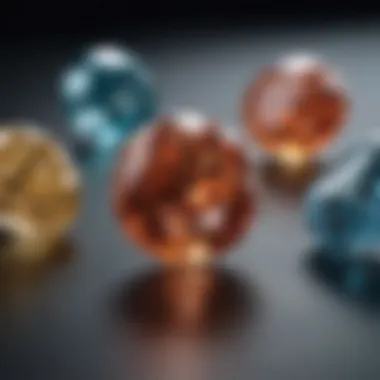

Several attributes are significant in confirming the quality of lab-made stones:
- Clarity: Lab-made diamonds can feature fewer inclusions than some natural diamonds, often resulting in a higher clarity rating.
- Color: While lab-made diamonds are available in various colors, their color consistency is generally superior to most natural options.
- Carat Weight: Lab-made gems can be produced in any size without the limitations of mining, allowing for more variety in carat weights.
In summary, lab-made diamonds stand as authentic gemstones with proven properties that rival their natural counterparts. This authenticity is reinforced by ethical practices and an increase in consumer demand, leading to a redefined perception of what constitutes a "real" diamond in today’s evolving market.
Distinguishing Lab-Made and Natural Diamonds
Understanding how to distinguish lab-made and natural diamonds is vital. This knowledge not only helps consumers make informed decisions but also impacts the overall perception of diamonds in the market. Both types of diamonds may appear similar to the untrained eye, yet they possess unique characteristics that speak to their origin.
Recognizing the differences ensures buyers understand the value, authenticity, and implications of their purchases. It also addresses many misconceptions surrounding lab-made diamonds, thereby shedding light on ethical considerations within the diamond industry.
Visual and Microscopic Differences
The visual differences between lab-made and natural diamonds are often subtle and, in many cases, imperceptible to the casual observer. However, gemologists utilize specialized equipment to identify these differences. Natural diamonds often contain unique inclusions and impurities formed over millions of years. These characteristics reflect the stone's natural geological history.
In contrast, lab-made diamonds, produced in controlled environments, may exhibit a different set of inclusions. For instance, some might display specific growth patterns that are only visible under magnification. These differences, known as "inclusions," might include circular patterns or specific crystal structures, which can indicate their synthetic origin.
Technology plays a significant role in identifying these discrepancies. Techniques such as spectroscopy or electron microscopy can highlight the specific traits of each type of diamond. Understanding these visual and microscopic facets is crucial for anyone in the gemological field, as it informs the grading and assessment of diamonds.
Grading and Certification
Grading lab-made and natural diamonds involves similar criteria but applies them in unique contexts. Both types of diamonds undergo evaluations based on the Four Cs: Carat, Cut, Color, and Clarity. These parameters are essential in determining the quality and market value of diamonds.
When it comes to certification, organizations like the Gemological Institute of America (GIA) or International Gemological Institute (IGI) provide detailed reports for both lab-made and natural diamonds. Certification for lab-made stones often includes a clear designation of their synthetic origin. This transparent labeling helps consumers understand what they are buying.
The differences between grading lab-made and natural diamonds allow buyers to recognize the economic implications. Lab-made diamonds often come with a lower price point compared to their natural counterparts. Additionally, being aware of the certification process can lead to a more educated purchase, aiding in the avoidance of scams and promoting informed consumerism.
The journey to understanding diamonds is not just about aesthetics but also about the underlying values and principles guiding diamond production. In a world increasingly concerned with ethics, knowing how to tell the difference can shape consumer behavior significantly.
Ethical Considerations of Lab-Made Diamonds
The ethical considerations surrounding lab-made diamonds are vital in today's jewelry market. As consumers become more conscious of the impact of their purchases, the demand for conflict-free and environmentally responsible options rises. Lab-made diamonds provide alternatives that address many moral concerns associated with natural diamond mining. This section explores these aspects in detail, focusing on conflict-free status and environmental impacts.
Conflict-Free Status
One significant advantage of lab-made diamonds is their conflict-free status. Natural diamond mining has been linked to human rights violations, environmental degradation, and funding of armed conflicts, particularly in regions such as Africa. In contrast, lab-created diamonds come from controlled environments, eliminating the risk of conflict financing.
- Transparency: Consumers can verify the source of lab-created diamonds, ensuring they are not contributing to unethical practices.
- Traceability: Lab diamonds typically come with certifications ensuring their ethical production, providing peace of mind to buyers.
The assurance that a diamond is conflict-free resonates particularly with socially conscious consumers. Being able to choose a diamond that upholds ethical standards helps buyers feel more connected to their purchase, turning jewelry into a statement of values rather than a source of moral ambiguity.
Environmental Impact
The environmental impact of diamond mining is another area of concern. Traditional mining practices often lead to habitat destruction, soil erosion, and significant carbon footprints. The process of extracting natural diamonds can be devastating to local ecosystems. In contrast, lab-made diamonds are produced using methods that generally require fewer natural resources.
- Reduced land disturbance: Lab-created diamonds require minimal land disruption compared to extensive mining operations.
- Lower energy consumption: Technological advancements in the diamond replication process often result in lower energy use.
"Lab-made diamonds present an opportunity to enjoy beautiful gemstones without compromising on ethical standards or environmental sustainability."
By providing a more sustainable option, lab-made diamonds appeal to an audience that prioritizes environmental responsibility. As the jewelry industry evolves, understanding these ethical considerations is crucial for informed decision-making. This insight serves not only to enhance consumer awareness but also to foster a more sustainable future for the diamond market.
Market Perception of Lab-Made Diamonds
Market perception is crucial in the diamond industry. It shapes consumer behavior and influences buying decisions. In recent years, lab-made diamonds have garnered attention as viable alternatives to natural diamonds. This section explores the factors contributing to market perception and how they affect consumer attitudes and sales in this evolving landscape.
Consumer Preferences
Consumer preferences for diamonds have shifted substantially in the past decade. An increasing number of buyers are favoring lab-made diamonds for various reasons.
- Ethical Concerns: Many consumers are drawn to lab-made diamonds because they perceive them as more ethical. These diamonds avoid issues associated with blood diamonds, which are mined in conflict zones and linked to human rights abuses.
- Sustainability: The environmental impact of mining is another key concern for consumers. Lab-made diamonds are often viewed as a more sustainable choice since their production typically requires less land use and harms fewer ecosystems than traditional mining.
- Value for Money: Lab-made diamonds are usually more affordable compared to natural diamonds. Consumers appreciate the possibility of acquiring larger or higher quality stones at a lower price point, making them more accessible.
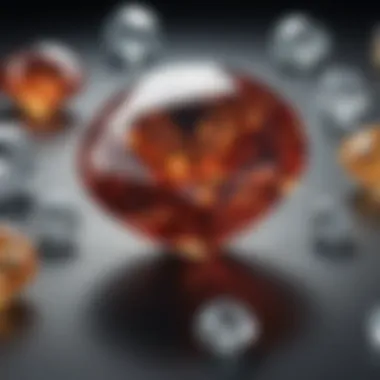

The shift in preferences reveals that modern consumers are becoming increasingly educated about their choices. They often prioritize social responsibility and personal values over tradition.
Price Comparison with Natural Diamonds
Price remains a significant factor in the decision-making process for consumers. Lab-made diamonds typically cost 20%-40% less than their natural counterparts. This price advantage arises from several factors:
- Production Efficiency: The methods of creating lab-made diamonds, such as HPHT and CVD, enable manufacturers to produce gemstones more efficiently. This results in lower costs that can be passed on to the consumer.
- Market Dynamics: The lab-made diamond market is growing, which increases competition among producers. This competition often leads to more favorable pricing for consumers compared to the more established natural diamond market.
- Perceived Value: While lab-made diamonds are cheaper, some consumers still hesitate. They may perceive natural diamonds as having more intrinsic or sentimental value. Yet, as marketing efforts and education about lab-made diamonds increase, the price difference may play a crucial role in attracting buyers.
"The lab-created diamond market is rapidly evolving, paving the way for a shift in how consumers perceive luxury combined with ethical choices."
Understanding these dynamics is essential not just for consumers, but also for stakeholders in the diamond industry. By recognizing changing consumer preferences and pricing structures, stakeholders can adapt their strategies and address potential gaps in the market.
Cultural Significance of Diamonds
The cultural significance of diamonds goes beyond their physical properties and market values. Throughout history, diamonds have been symbols of wealth, power, and love. This article section explores the role of diamonds in various cultures and their evolving significance in modern society, especially focusing on the rise of lab-made diamonds.
Historical Context of Diamonds
Diamonds have captured human fascination for centuries. Initially discovered in India, they were seen as sacred stones. In ancient times, they were thought to have mystical properties, including protection against evil. The increasing demand for these gemstones came with the rise of trade routes.
By the Middle Ages, diamonds became associated with royalty and the upper class. They adorned crowns and scepters, serving as status symbols. The phrase "Diamonds are Forever" emerged as a marketing slogan in the 20th century, cementing their place as the quintessential gemstone for engagement rings. This transformation highlights how diamonds have morphed into cultural icons, often linked to significant life events such as weddings.
However, the historical context also includes darker aspects, such as the exploitation of workers in some diamond mines. This has led to a growing awareness of the ethical implications surrounding diamond sourcing. As such, the rise of lab-made diamonds has provided an alternative that carries less ethical baggage.
Lab-Made Diamonds in Modern Society
In recent years, the cultural narrative around diamonds has shifted. Lab-made diamonds are gaining acceptance and respect. They appeal not only to environmentally conscious consumers but also to a new generation who seek authenticity in their purchases. These diamonds represent innovation in jewelry, being both aesthetically pleasing and ethically produced.
Here are some reasons why lab-made diamonds are becoming significant:
- Accessibility: Lab-made diamonds often come at a lower cost than natural diamonds, making them accessible to a wider audience.
- Ethics: They eliminate concerns related to blood diamonds, offering a conflict-free choice.
- Personalization: Consumers can select specific features, like size and cut, without the constraints of supply dictated by nature.
"Lab-created diamonds are not just a trend; they reshape what we consider valuable in the world of gemstones."
As society embraces these ethically produced gems, they are recontextualizing their meaning. No longer just symbols of traditional wealth and love, lab-made diamonds are becoming emblems of progressive values, responsible consumerism, and technological advancement. The intersection of culture and gemology grows richer with each innovative step, redefining what it means to adorn oneself with diamonds.
The Future of Lab-Made Diamonds
The future of lab-made diamonds presents a significant evolution in the gemstone industry. This sector continues to flourish, as both technology and consumer preference shift. Understanding this future is crucial for enthusiasts, collectors, and jewelry designers, as it shapes the market landscape and influences purchases.
Technological Advancements
Recent years have seen remarkable advances in the production technologies of lab-made diamonds. High Pressure High Temperature (HPHT) and Chemical Vapor Deposition (CVD) methods are being refined. Innovations in these techniques lead to faster production times and improved diamond quality.
These advancements are not only about efficiency. They also focus on producing diamonds that match or exceed the quality of natural diamonds. Enhanced clarity, larger carat sizes, and rich colors become more attainable.
Furthermore, research into the use of alternative carbon sources and improved environmental controls in production heralds a more sustainable industry. This sustainability is becoming a priority for many consumers, who often prefer products with minimal ecological footprints. A continuous investment in technology is imperative to staying ahead in this competitive market.
Projected Trends in Consumer Demand
Consumer demand for lab-made diamonds is on the rise. This reflects a growing awareness and appreciation for the ethical implications of diamond sourcing. Buyers increasingly favor conflict-free stones, prompting a shift towards lab-grown alternatives.
Key trends include:
- Increased Acceptance: As consumers become educated, acceptance of lab-made diamonds rises, matching their natural counterparts in desirability.
- Market Segmentation: Different demographics exhibit varying levels of interest, particularly millennials and Gen Z, who often prioritize sustainability in their purchases.
- Design Innovation: Jewelry designers are responding to the rise in lab-made diamonds by creating unique styles specifically for these gemstones. Customization options grow more prevalent, amplifying their appeal.
Closure
The conclusion serves as a critical component in understanding the full scope of lab-made diamonds. It synthesizes information explored throughout the article, allowing readers to grasp the importance of the topic holistically. In this section, several key elements will be highlighted, illustrating both the significance and potential impact of lab-created gemstones on the jewelry market and society at large.
Summary of Findings
Lab-made diamonds are a captivating subject that interweaves science, ethics, and consumer behavior. The research presented in this article demonstrates that these diamonds possess identical physical and chemical properties to natural diamonds, thus affirming their authenticity. Moreover, the production methods such as High Pressure High Temperature (HPHT) and Chemical Vapor Deposition (CVD) reveal the intricate processes involved in creating these gems.
Additionally, consumers increasingly favor lab-made diamonds for various reasons, including ethical considerations and environmental impacts. The diamonds emerge as a conflict-free alternative to natural stones, appealing to an environmentally conscious audience. The findings illustrate a shift in market perception, where many consumers now acknowledge and embrace these gems as legitimate and valuable.
Final Thoughts
The landscape of the diamond industry is evolving rapidly, with lab-made diamonds at the forefront of this transformation. As we move toward a future that prioritizes sustainable choices, the acceptance of lab-created stones is likely to increase. Jewelers, enthusiasts, and collectors must adapt to this change, recognizing the significance of lab-made diamonds in both personal and cultural contexts.



